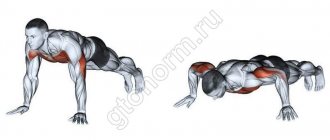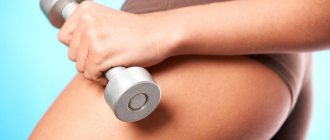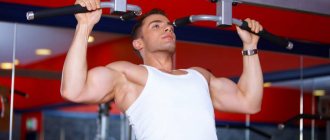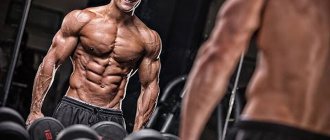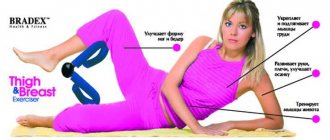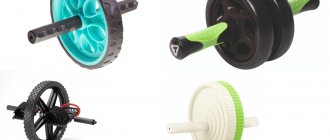Push-ups are a popular type of exercise that allows you to train all muscle groups in any conditions and maintain good physical shape. Push-ups do not require special equipment or special preparation, and thanks to the large number of options, you can choose an exercise for any level of physical fitness. In this article we will look in detail at the types of push-ups for different muscle groups.
With your hands shoulder-width apart
A classic technique for pumping up the muscles of the arms and back. It is recommended to do 30 to 40 push-ups in one approach. Only after three problem-free approaches in a short period of time can you move on to more complex types. To perform this, you need to take a lying position and place your hands shoulder-width apart.
Features of the exercise:
- to reduce tension in the neck, you need to keep your head straight;
- when bending your arms, the body should practically touch the ground;
- you need to return to the starting position smoothly.
Note! You need to constantly monitor your breathing. When lowering the body, inhale, when lifting, exhale. To increase exposure, you can linger at each point for a few seconds.
Technique for performing push-ups while standing against a wall
The exercise, due to its simplicity and versatility, can be performed both at home and in the gym. Learning a technique is an important step on the path to practice. It depends only on the technique whether push-ups will be beneficial or will go in vain. Thus, we offer two options for performing wall push-ups: with wide and narrow arms.
Option 1. With arms wide
In such push-ups, a large emphasis is placed on the pectoral muscles, while the back and abdominal muscles are less active. The main difference is that the hands are located at a great distance from each other. Number of approaches: 3, number of repetitions: 15–17.
- Stand so that there is approximately 1 step between you and the wall.
- Straighten your arms towards the wall and focus.
- Place your hands wider than your shoulders so that you can comfortably bend your elbows.
- Start leaning your body towards the wall, bending your arms at the elbow joint.
- Your fingers should point either up or slightly to the sides.
Option 2. With narrow arms
To engage the triceps muscles (aka triceps), place your hands closer to each other. You will feel the load smoothly move from your chest to your arms. In this version of push-ups, the muscles of the abdomen and back work to a lesser extent.
- Take a step away from the wall, lean forward, keeping your back straight.
- Focus on outstretched arms.
- Collect your feet, press your legs together.
- Place your hands less than shoulder-width apart.
- Start bending your elbows, leaning towards the wall and pushing away from it.
Number of sets and reps: 3 x 15.
Wall push-up technique
Wall push-ups: correct technique for wide stance
Push-ups from the wall: correct technique with wide stance of the armsVideo instructions for the exercise:
httpv://www.youtube.com/watch?v=embed/aUEKSdPUS5g
Non-classical variations of the exercise include: push-ups from the wall sideways on one arm and push-ups from the wall with clap.
One-arm wall push-ups are a challenging push-up variation that you can try as a variation in your workout. After all, muscles tend to get used to the same load, and in order to actively develop them, you need to modify the exercises or select alternative ones.
One-arm wall push-ups
Options for complete wall push-ups on one arm
Options for performing one-arm wall push-ups Target muscle: triceps. Technique:
- Stand with your side to the wall.
- Place your emphasis on your left (or right) hand so that your palm is parallel to the floor and your fingers point not up, but to the side.
- Begin to lean your body toward the wall, bending your elbow.
- Follow the breathing technique: exhale from the starting position, bend to the side - inhale.
- Change hands after performing the exercise.
The number of approaches for each hand is 2.
Number of repetitions: - 15.
Video instruction on how to do push-ups from a wall sideways on one arm.
httpv://www.youtube.com/watch?v=embed/FYDIGYzzgns
Many people have probably seen how they do push-ups with cotton. But why make cotton? Does it affect anything? Clapping push-ups are aimed at training explosive strength. The goal of such push-ups is to develop powerful strength in a small amount of time (fractions of a second). You simultaneously develop agility, speed, strength and activate the fat burning process. If you have weak triceps and problems with excess weight in the shoulders and arms, do wall push-ups with clap.
Exercise technique
Wall Push-Ups with Clap: Developing Explosive Strength
Wall push-ups with clap: developing explosive strength Technique:
- Stand against a wall as in a classic push-up.
- Focus on straightened arms, palms facing up.
- Bend your body forward, bending your elbows.
- While bending over, make a sharp push back and make a clap.
- After the clap, return to the starting position.
- Your body should work like a pendulum: push back - shift the center of gravity - clap - starting position in an inclined position.
Video instruction: push-ups from the wall with cotton
httpv://www.youtube.com/watch?v=embed/Mgey2L7kIv4
With arms wide
Designed to train deep and superficial chest muscles. The main difference from the classical technique is that the arms are located almost 1.5-2 times wider than the shoulders. When bending, the torso should come into contact with the floor. This position requires fixation for several seconds. When returning to the starting position, it is necessary to tense the chest muscles.
Advice! At first, it will be difficult to learn a new technique and give commands to the body to tense the thoracic region. Therefore, it is better to first study the features of push-ups, do several approaches, and only after that connect brain control. Personal fitness training is great.
Reverse push-ups - essence, advantages, recommendations
The main task of reverse push-ups is to work the triceps, which beginner athletes completely undeservedly forget about, focusing all their attention on the biceps. Reverse push-ups, or reverse-grip push-ups as they are also called, are not just for the triceps, they help work the anterior deltoid and upper pectoral muscles
And in some variations, even the abdominal muscles
Reverse push-ups, or reverse-grip push-ups as they are also called, are not just for the triceps, they help work the anterior deltoid and upper pectoral muscles. And in some variations of the exercise, even the abdominal muscles.
In addition to the ability to work more than one muscle group, reverse push-ups have some other advantages:
- The exercise helps to work all three heads of the triceps, which is not always possible when performing other exercises.
- A well-developed triceps increases the effectiveness of performing exercises for the chest muscles (for example, bench press).
- Due to the ability to choose the position and perform the exercise without weights, reverse push-ups are suitable for beginners and women.
- This type of exercise does not require special equipment or training equipment. You can perform reverse push-ups at home and even on the street.
In order for your training to be effective and the results to be immediate, it is important to follow some recommendations:
- reverse push-ups should be performed at the beginning of a triceps workout, since these exercises are quite energy-intensive;
- It is recommended to train the triceps once a week on the day of training the arms and shoulder girdle;
- Perform push-ups 10-15 times up to 4 approaches;
- pause for up to 1 minute between approaches;
- At first, carefully work out the technique;
- Perform the exercise at a moderate pace - no sudden jerks or long delays.
Now let's take a closer look at what types of reverse push-ups exist and the technique of each of them.
With a narrow hand position
Also known as diamond exercises due to their excellent work on the deep pectoral muscles. At the same time, the technique itself is more reminiscent of a bench press.
Execution steps:
- Place your arms straight on the floor, with your index fingers and thumbs touching each other.
- Smoothly lower to the bottom position, lightly touching the floor.
- Actively push the body back to its original position.
- Tighten your muscles and hold static for a few seconds.
- Repeat the exercise.
This type of push-up is considered one of the hardest, as you need to properly redistribute the load and maintain balance. Therefore, a set of 10-15 push-ups should be done at the beginning of your workout for greater effectiveness.
Diamond
These are push-ups with narrow palms. The fingers form a shape reminiscent of an inverted diamond. In this position, the inner chest and triceps are well worked out.
How to do it:
- Take a lying position.
- Place your palms under your chest and align your index fingers and thumbs.
- Lower your chest toward your palms, gently bending your elbows.
- Straighten up and repeat the movement.
Narrow hand position (Photo: journal.spotonline.ru)
Diamond push-ups can be performed from the wall.
On one hand
Used to increase the load. This is done alternately on each hand. The emphasis is on the feet and one hand, the second should be behind the back. The technique is the same as for classic push-ups. It is necessary to pay attention to breathing.
Recommendation! If after doing push-ups on one arm, pain appears in the hand, this means that the ligaments, joints and muscles are not yet ready for such loads. In order to avoid injuring your hand, you first need to exercise with an expander, bend your wrists with a load, and rotate.
Main mistakes and contraindications
The effectiveness of the exercise increases technicality in combination with compliance with a number of conditions. Typical mistakes when performing push-ups:
- placing the arms too wide and moving the elbows to the sides;
- delay in the upper phase with straightened arms; this puts a lot of stress on the elbow joints and reduces the effectiveness of “failures”; optimally do push-ups without stopping at the end points - this contributes to the best blood supply to the muscles;
- performing reverse push-ups and dips on uneven bars in one workout; exercises are characterized by similar biomechanics - there is a high risk of overtraining the triceps;
- performing movements on an unstable surface; this interferes with concentration, which ultimately determines the effectiveness of the training as a whole.
You shouldn't do push-ups if you have shoulder injuries.
If you have had injuries in the past, you need to train very carefully, without overloading the shoulder joints. In any case, before “failures” you should warm up thoroughly - warmed up muscles and ligaments are much more “loyal” to the load
At your fingertips
Some types of push-ups for different muscle groups for men are designed for complex levels of training. This type is an ideal way to strengthen the muscles of the forearms, hands, and chest. First you need to take a classic position while lying down, then place your hand touching the floor exclusively with your fingertips.
Differences from other types:
- in the lower position, the elbow bends at an angle of 90 degrees;
- the chest is held 4-5 cm above the floor, without touching the floor with the body;
- return to the original position is carried out only by pushes, an impulse emanating from the shoulder girdle.
This type of exercise is complex, so the muscles of the hands need to be well developed. It is important to warm up your fingers and wrists first.
Features of the exercises
The first thing that needs to be sorted out is the benefits and harms of such exercises. Different techniques are selected for men and women to train the necessary parts of the body. It is also worth considering that the benefits of push-ups only appear if they are performed correctly.
The video shows all types of push-ups by difficulty level
We also recommend studying this topic:
Basic CrossFit exercises for a good men's workout
9117 0 0
Benefits of classes
To maximize results, it is important to perform push-ups correctly. The benefits for men and women are generally the same, but each person's goals are different. With these exercises you can achieve the following results:
- improve your figure, tighten your arms, chest, stomach;
- increase strength, agility, endurance, impact speed;
- train the heart muscle, blood vessel, respiratory system;
- speed up metabolism and lose excess weight;
- gain muscle mass;
- strengthen bones and joints.
Depending on the type of exercise chosen, different muscle groups are affected. Mainly work the shoulders, chest and triceps. The abs and intercostal muscles, calves, thighs and buttocks, back, and forearm also receive a share of the load.
Affected muscle groups with different hand positions
Important: as a result of training, a person’s posture and general condition of the body will improve, and the muscles will gain strength and attractive relief.
Harm and restrictions
It is not enough to understand why push-ups are useful. Any sports activity can harm a person if the basic rules are not followed:
- Before classes, you need to stretch your joints and warm up your muscles;
- do not overload the body;
- follow the correct technique for performing the exercise.
If you perform the exercise incorrectly, you risk injury.
Push-ups can lead to negative consequences such as dislocations or sprains. The hands and shoulder joints are especially affected. People with fragile bones should not exceed the permissible load. In addition, some restrictions apply to women, as well as people with vascular, heart and respiratory problems. In order not to worsen your appearance, do not pump the same muscle group in isolation, supplement your workouts with other exercises, and follow a rest regime.
Readers found these materials useful:
- Nordic walking with poles: benefits and technique
- We increase our own endurance through circuit training
With support on your knees
An ideal push-up technique for beginner athletes who do not want to overstrain their lower back and back muscles. All types of push-ups provide a load, so it’s best to start simple.
Procedure for performing the exercise:
- Take a classic position, placing only your knees on the floor.
- As you inhale, bend your elbows and lower your body to the floor. At first you can touch the floor, but then the torso should be at a height of 1-3 cm.
- As you exhale, straighten your arms, return to the starting position and fixate.
The shins should be kept straight and not raised up, as this can put extra stress on the lower back. At the same time, the pelvis should not rise either, the body remains elongated. The fitness bar in the club will help you replenish your water balance.
Types of handstand push-ups
It would seem that this is already a technically complex exercise in which there cannot be any variations. However, there are still options that we will consider below:
- Hand push-ups without support. The variation has a high level of complexity, since the legs do not rest on the plane. Those. the position of the body in space is controlled solely by the stabilizer muscles. This variation will require the trainee not only to be in excellent physical shape, but also to have the skills to control his own body. You need very good coordination in order not to fall. Therefore, at first, the help of a partner is required.
- Kipping. In this variation, in the overcoming phase, the legs are involved in the movement, which is a kind of cheating. It looks like this - at the bottom point, the legs bend at the knees and are pulled towards the chest, and during the rise they straighten, creating a moment of inertia. This makes it easier to push the body upward. This technique allows you to perform more repetitions. Popular in CrossFit.
With support on one leg
Exercise for advanced level. It is required to maintain body stability, balance, and make much more effort. The starting position is the same as in the classical technique, but one leg should be on the other: only the toe of one foot touches the floor from below. Elbows should be kept as close to the body as possible. Lowering the body is done while inhaling; while exhaling, you need to push yourself off the floor.
Where to start training push-ups
Despite the apparent simplicity of the push-up technique, it is still worth considering a number of nuances:
- Exercise in moderation. Avoid excessive stress, especially in the first lessons. In this case, it is quality that matters most.
- Don't rush to get results quickly. Push-up training should gradually become more difficult, and preparation for the next level of load can last several weeks. As soon as the muscles are sufficiently strong and the required number of push-ups is easy, then you can increase the load.
- Follow breathing technique. This plays an important role. Incorrect breathing technique can disrupt the entire training process.
Head up and head down with support on a fitball or bench
- When resting your feet on a fitball or bench, your head will be located at or below your torso. Develops pectoral muscles, abdominal and arm muscles, triceps. Initial position: feet are on the fitball, hands rest on the floor, face is 3 cm from the floor. The support of the legs should be located under the feet. It is important to maintain balance.
- When resting your hands on a fitball or other object, in order to develop all muscle groups of the upper body, you need to kneel and then put your hands on it. The toes rest on the floor, the chest is located directly above the object. When bending, your elbows should be at a 90 degree angle.
These types of push-ups require constantly straining the body and controlling each muscle group. Therefore, you can start this push-up technique only after serious preparation, as you can injure your hips and arms.
From my knees
Perhaps the easiest way to push your own weight off the floor. The lower, middle pectoral muscles and triceps are trained. Knee push-ups are recommended for overweight people and beginners in the sport who find it difficult to do even classic push-ups. Performed on a mat.
How to do it:
- Lie on your stomach.
- Lift your shins, transfer your weight to your knees and at the same time straighten up on your arms.
- Bend your elbows and smoothly lower your body towards the floor.
- Straighten up to the original position, repeat the movement.
Do not bring your arms forward, place them at shoulder level (Photo: 3kmu.ru)
Keep your body straight: hips, buttocks, back, neck form one line at an angle of 45 degrees to the floor. Your palms should be exactly under your shoulders. When lowering the body, the elbows look in different directions.
You can perform other push-up variations on your knees: with your arms wide, narrow, on one leg or arm, etc.
On the uneven bars
A popular and accessible exercise for activating the muscles of the shoulders and chest. There are different types of dips, but the most common is this technique:
- Jump onto the projectile, then carefully tilt the body 30 degrees.
- You need to lower your body down while inhaling, spreading your elbows to the side.
- As you exhale, tighten your chest muscles and lift yourself to the original position.
The high load on the shoulders and arms makes the exercise dangerous. Therefore, if you have previously had injuries, it is better to refrain from independent practices. For exercise, it is better to go to the fitness center.
Push-ups allow you to constantly keep your body in good shape, maintain muscle definition, strength and endurance. Most often in practice, combined techniques are used to work all muscle groups. It is recommended to contact an experienced fitness trainer to create an individual training program.
Benefits of push-ups
This exercise is a basic one - when several muscle groups are involved at once:
- breast;
- shoulder girdle;
- arms (biceps and triceps);
- abdominal muscles.
During push-ups, it is possible to shift the emphasis to those muscle groups that you want to use (triceps, shoulders, chest - read on about this) - in order to emphasize the load, you need to redistribute the load.
The peculiarity of push-ups is that muscle activation occurs immediately after taking the starting position. Regular push-ups help build strength and increase endurance. Some other benefits of push-ups should be noted:
- the respiratory and circulatory systems are strengthened;
- metabolic processes improve;
- The body's immune strength increases.
Thanks to regular training, even at home, muscle tone significantly increases and muscle mass increases. Not every exercise can boast such results. The undoubted advantage of push-ups is:
- the possibility of their implementation in childhood
- no special equipment required
How to make reverse push-ups more effective?
After mastering the exercise performed with your own weight, you can increase the effectiveness of “failures” with the help of weights. This can be done for both boys and girls. Women do not need to fear transformation into masculine beings. In most cases, training with additional weight will not cause the growth of “feminine” muscles. But they will help make your figure more attractive.
When training in the gym, they usually use weight plates. When working out at home, you use improvised means - a backpack with weights, dumbbells, a closed container of water. The weight is placed on the front of the thigh. Moreover, first they fix the additional weight, and only then put their feet on the bench.
There is no need to place weights on the knees. Try to place it closer to the pelvis. This will protect your knee joints from injury. Even if you feel strong enough to lift a lot of weight straight away, you shouldn’t do it. Perhaps your muscles are already ready for such a load, but let them get used to the weight and ligaments.
Jumping push-ups
A fairly complex exercise designed for people who already know how to do classic push-ups at least 30 times. This type of push-up is aimed at developing the athlete’s explosive strength. By performing jumps, the load on the pectoral muscles increases significantly and the exercise becomes more intense. It can be performed either with or without throwing your legs over the bench, the load will be distributed accordingly - to the upper or middle sections of the chest.
In this version of the exercise, the triceps also receive a significant load. To reduce it, you need to do push-ups with jumps only from the floor, leaving the width of your arms unchanged, as shown in the previous exercise.
Classic look
This option is included in the regular school curriculum, so many had to do it in physical education lessons. The best push-up technique is simple:
- a supine position is adopted, with the palms and toes playing the role of supports;
- legs and back are a single line;
- The palms should be placed wider than the shoulders, with the fingers pointing forward;
- feet can be kept together or hip-width apart;
- the downward movement is performed while exhaling, slowly approaching the floor;
- when bending the elbows, there is no need to move to the sides;
- you need to return to the original state by exhaling.
Finger push-ups allow you to complicate the classic technique. The execution is similar, but instead of the emphasis you need to use your fingers, not your palms.
Various push-ups
Push-ups are usually divided into hand width (narrow, medium, wide), hand position (distance/approximation of knees from/to the torso) and the use of training equipment. There are also modifications in each of these groups. Depending on the type of push-ups you choose, you can use different muscles to work.
Classic push-ups
Hands are placed slightly wider than shoulder-width apart. We place and straighten our arms on the floor, and rest our feet on our toes. Then we tense the muscles of the buttocks and abdomen - the body should be in a straight line. The movement consists of bending your arms to approximately 90 degrees and lowering your body (while inhaling). This is followed by straightening the arms and raising the body (as you exhale).
“Women’s” push-ups
This type of push-up is characterized by a much simpler technique. The starting position is similar to classic push-ups. The only change is the position of the legs on slightly bent knees. Your buttocks should be in line with your back. The exercises are performed in the same way as in the case of classic push-ups.
How do push-ups work?
The classic version of push-ups consists of bending and straightening your arms in a support position in front. The entire movement is based on lowering and raising the body. This exercise works the muscles of the arms and chest. So push-ups are an excellent exercise for developing the muscles of the shoulders, arms, chest, buttocks, thighs and abdomen.
The joints also involved are the elbows and shoulders. Push-ups work well in strength, gymnastics, endurance or general training.
Muscle work during push-ups
Different types of push-ups work different muscles. Above is a graph showing which muscle groups work the most.
Regular push-up exercises can improve your overall strength, strength, and fitness. Moreover, they have a huge impact on shaping the body, especially the abdomen, chest and arms.
How many repetitions should I do?
The number of repetitions and sets depends largely on the role push-ups play in your training program.
- If push-ups are one of the exercises you use to bulk up your chest or arms, then do 8-12 reps in 3-4 sets. When performing this volume freely, perform the exercise with additional weight or master more complicated variations.
- If you need relief and burning excess fat, perform 15-20 relatively fast repetitions in 3-4 sets, in combination with other exercises.
- If push-ups are your main upper-body training exercise, and the goal is not so much bulk as overall strength and endurance, do as many reps and sets as possible. There are various programs and techniques aimed at increasing the number of push-ups.
Summarizing everything said above, we can say that push-ups are far from being an outdated atavism from school physical education lessons, but a whole complex of various functional exercises that allow you to effectively work the muscles of the upper body, develop strength and endurance. Train with pleasure and the results will not take long to arrive!
